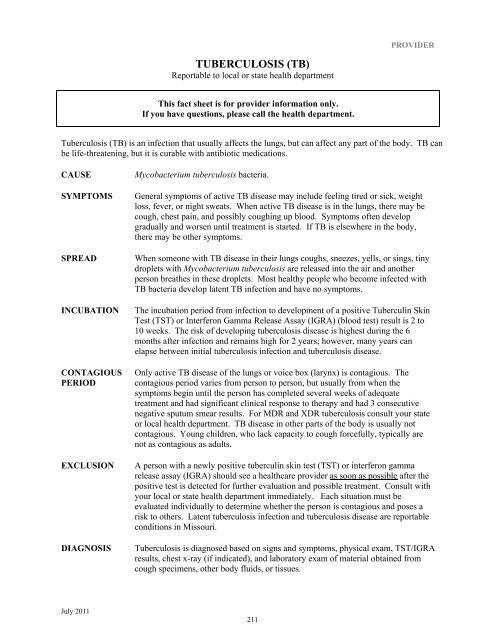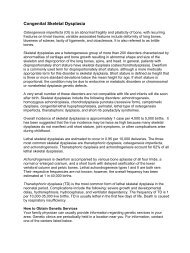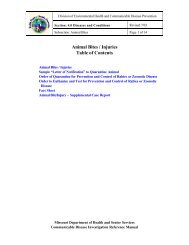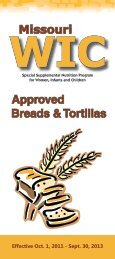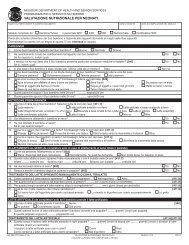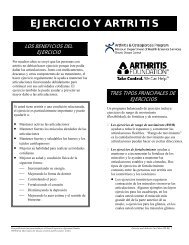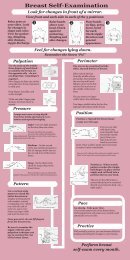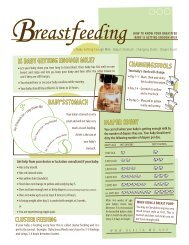Prevention and Control of Communicable Diseases - Missouri ...
Prevention and Control of Communicable Diseases - Missouri ...
Prevention and Control of Communicable Diseases - Missouri ...
Create successful ePaper yourself
Turn your PDF publications into a flip-book with our unique Google optimized e-Paper software.
July 2011<br />
TUBERCULOSIS (TB)<br />
Reportable to local or state health department<br />
This fact sheet is for provider information only.<br />
If you have questions, please call the health department.<br />
211<br />
PROVIDER<br />
Tuberculosis (TB) is an infection that usually affects the lungs, but can affect any part <strong>of</strong> the body. TB can<br />
be life-threatening, but it is curable with antibiotic medications.<br />
CAUSE Mycobacterium tuberculosis bacteria.<br />
SYMPTOMS General symptoms <strong>of</strong> active TB disease may include feeling tired or sick, weight<br />
loss, fever, or night sweats. When active TB disease is in the lungs, there may be<br />
cough, chest pain, <strong>and</strong> possibly coughing up blood. Symptoms <strong>of</strong>ten develop<br />
gradually <strong>and</strong> worsen until treatment is started. If TB is elsewhere in the body,<br />
there may be other symptoms.<br />
SPREAD When someone with TB disease in their lungs coughs, sneezes, yells, or sings, tiny<br />
droplets with Mycobacterium tuberculosis are released into the air <strong>and</strong> another<br />
person breathes in these droplets. Most healthy people who become infected with<br />
TB bacteria develop latent TB infection <strong>and</strong> have no symptoms.<br />
INCUBATION The incubation period from infection to development <strong>of</strong> a positive Tuberculin Skin<br />
Test (TST) or Interferon Gamma Release Assay (IGRA) (blood test) result is 2 to<br />
10 weeks. The risk <strong>of</strong> developing tuberculosis disease is highest during the 6<br />
months after infection <strong>and</strong> remains high for 2 years; however, many years can<br />
elapse between initial tuberculosis infection <strong>and</strong> tuberculosis disease.<br />
CONTAGIOUS<br />
PERIOD<br />
Only active TB disease <strong>of</strong> the lungs or voice box (larynx) is contagious. The<br />
contagious period varies from person to person, but usually from when the<br />
symptoms begin until the person has completed several weeks <strong>of</strong> adequate<br />
treatment <strong>and</strong> had significant clinical response to therapy <strong>and</strong> had 3 consecutive<br />
negative sputum smear results. For MDR <strong>and</strong> XDR tuberculosis consult your state<br />
or local health department. TB disease in other parts <strong>of</strong> the body is usually not<br />
contagious. Young children, who lack capacity to cough forcefully, typically are<br />
not as contagious as adults.<br />
EXCLUSION A person with a newly positive tuberculin skin test (TST) or interferon gamma<br />
release assay (IGRA) should see a healthcare provider as soon as possible after the<br />
positive test is detected for further evaluation <strong>and</strong> possible treatment. Consult with<br />
your local or state health department immediately. Each situation must be<br />
evaluated individually to determine whether the person is contagious <strong>and</strong> poses a<br />
risk to others. Latent tuberculosis infection <strong>and</strong> tuberculosis disease are reportable<br />
conditions in <strong>Missouri</strong>.<br />
DIAGNOSIS Tuberculosis is diagnosed based on signs <strong>and</strong> symptoms, physical exam, TST/IGRA<br />
results, chest x-ray (if indicated), <strong>and</strong> laboratory exam <strong>of</strong> material obtained from<br />
cough specimens, other body fluids, or tissues.


